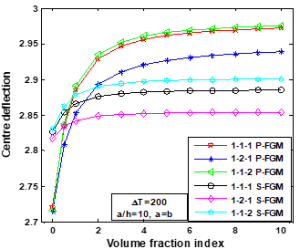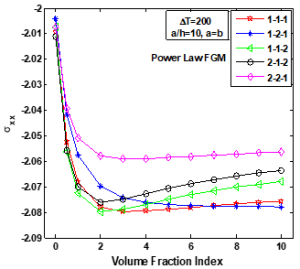Breakthrough in Nanosecond Laser Conversion for Clean Energy
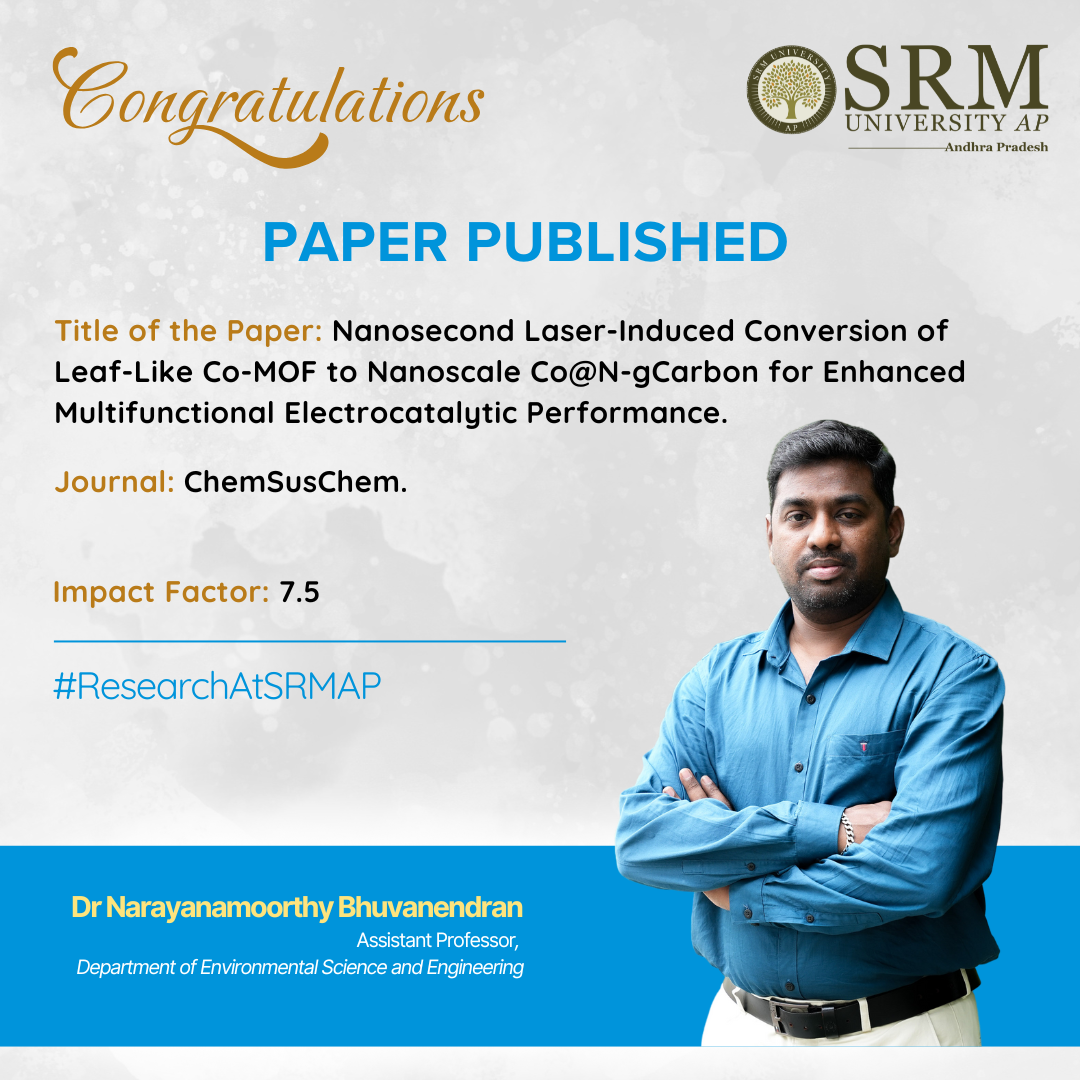
The paper titled “Nanosecond Laser-Induced Conversion of Leaf-Like Co-MOF to Nanoscale Co@N-gCarbon for Enhanced Multifunctional Electrocatalytic Performance” by Dr Narayanamoorthy Bhuvanendran, Assistant Professor, Department of Environmental Science and Engineering, was published in the ChemSusChem journal with a Q1 rating with an impact factor of 7.5. The study presents a breakthrough in clean energy research with an innovative nanosecond laser-based technique that transforms metal–organic frameworks into high-performance electrocatalysts faster, more energy-efficiently, and eco-friendly.
Abstract :
Conversion of metal–organic frameworks (MOFs) into metal-nitrogen-doped carbon (M–N–C) catalysts requires a high-temperature process and longer processing time under a protective atmosphere. This study utilises a low-energy nanosecond laser processing (LP) technique to convert aqueous synthesised 2D leaf-like Co-MOF (L-Co-MOF) into nanoscale cobalt metal encapsulated within a nitrogen-doped graphitic carbon matrix (Co@N-gC, Co-LP) in a shorter period under air atmosphere.
The laser-induced process results in the formation of Co@N-gC with smaller Co particle size, uniform distribution, and better interaction with the carbon support compared to the conventional pyrolysis process (CP). LP catalysts result in enhanced multifunctional electrocatalytic activity over CP (Co-CP) catalysts owing to the tunable metal–support interaction, higher charge transfer, and presence of multiactive sites.
Under optimised conditions (laser fluence: 5.76 mJ cm−2 and scan speed: 10 mm s−1), the Co-LP-5 catalyst exhibits better ORR performance, with onset and half-wave potentials of 0.92 and 0.76 V, respectively. Additionally, Co-LP-5 delivers excellent water-splitting performance, with OER and HER overpotentials of 380 and 280 mV, respectively, achieving an overall energy efficiency of 77.85%. Furthermore, Co-LP-5 demonstrates exceptional durability over 48 h of real-time testing, outperforming the Co-CP, and the proposed low-energy LP is viable for fabricating multifunctional catalysts.
The research focuses on developing new materials for more efficient clean energy production, specifically advanced catalysts that accelerate chemical reactions. Traditionally, creating an effective M–N–C (metal–nitrogen–carbon) catalyst requires heating metal-organic frameworks (MOFs) to high temperatures in oxygen-free environments, which is time-consuming and energy-intensive.
This study introduces a simpler, faster, and energy-saving approach using nanosecond laser pulses to transform cobalt-containing MOFs into a new material called Co@N-gC. This laser method operates in normal air, significantly reducing time and energy consumption. The resulting catalyst features smaller, evenly distributed cobalt particles that enhance interaction with the carbon support, leading to improved activity and efficiency in key energy reactions. Our laser-made catalyst, Co-LP-5, exhibited excellent performance over 48 hours, outperforming traditional methods. This breakthrough demonstrates that low-energy laser techniques can create powerful, multifunctional catalysts for clean energy more quickly, cheaply, and sustainably.
Practical implementation of the research :
We are working on developing new materials that help produce clean energy in a faster, cheaper, and more eco-friendly way. Usually, scientists use a high-heat process to convert materials called metal-organic frameworks (MOFs) into something called catalysts, which are substances that help speed up important chemical reactions, such as splitting water to produce hydrogen fuel or helping batteries and fuel cells work better.
However, the traditional method requires a lot of energy, time, and special conditions to work. In the study, we found a much simpler and faster way to make these useful catalysts. Instead of heating the material for a long time, we used a laser to quickly transform the MOF into a new material. We did this in normal air using short pulses of light from a laser, and within seconds, the material changed into a highly active form containing tiny cobalt particles surrounded by nitrogen-rich carbon. This new material works more efficiently and lasts longer than the one made by traditional heating.
Our method is not only quicker and more energy-efficient, but also easier to scale up for larger use. This laser technique can be used to create advanced materials for fuel cells, batteries, and systems that produce hydrogen from water. These technologies are crucial for clean energy and can help reduce pollution and dependence on fossil fuels.
The real-world impact of this research is significant. It can make clean energy technologies more affordable and accessible, especially in developing regions with limited energy access. It also supports the shift toward a greener economy by promoting sustainable methods and creating new opportunities in clean energy industries. In the long term, this work contributes to fighting climate change and protecting the environment by helping the world move toward cleaner, safer energy solutions.
Future Research Plans:
- Explore using different metal-based MOFs to develop a broader range of catalysts for clean energy applications.
- Optimise laser processing conditions such as energy, speed, and environment to improve the quality and performance of the final materials.
- Study the detailed mechanism of how the laser converts MOFs into active catalysts to better understand and control the process.
- Test the laser-made catalysts in actual energy devices like fuel cells and water-splitting systems to evaluate their real-world performance.
- Investigate methods to scale up the laser processing technique for larger production while keeping it cost-effective and energy efficient.
- Expand the application of these materials to other areas such as carbon dioxide reduction, hydrogen storage, or environmental sensing.
Collaborations:
Prof. Sae Youn Lee, Dongguk University, Republic of Korea.
Dr. Srinivasan Arthanari, Chungnam National University, Republic of Korea.
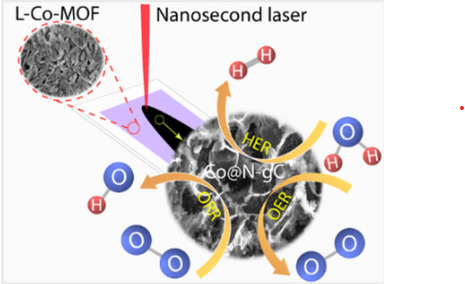
- Published in Departmental News, ENVS News, News, Research News
Review of The Bloomsbury Handbook to the Digital Humanities (DH)
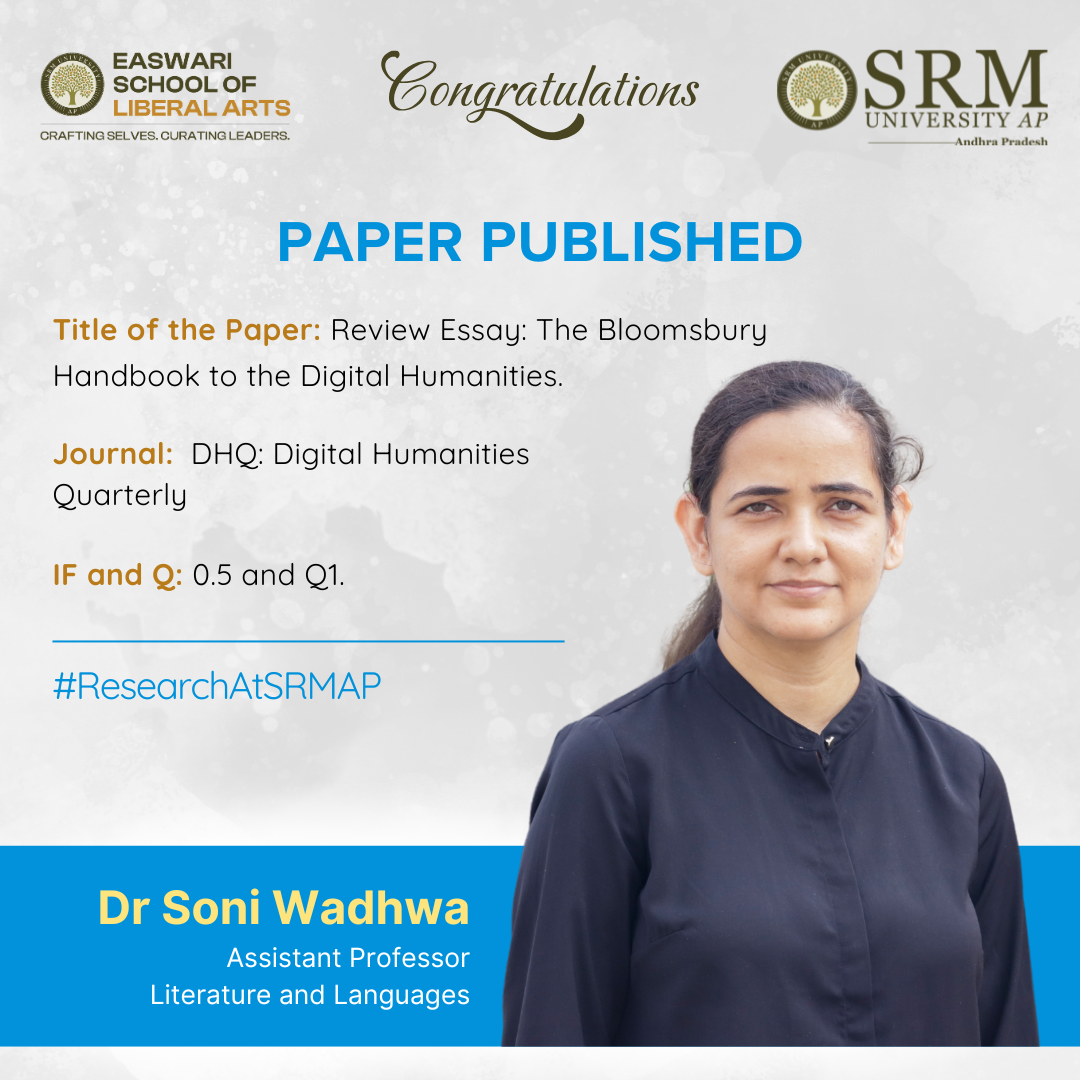 A handbook is a complex and demanding genre, it must offer a comprehensive overview of a field, articulating its foundational principles, charting ongoing debates, and identifying potential future directions. Such volumes are often judged as much by what they exclude as by what they include. Within this context Dr Soni Wadhwa, Assistant Professor in the Department of Literature and Languages, approached “The Bloomsbury Handbook to the Digital Humanities” in her review essay published in the Q1 journal “DHQ: Digital Humanities Quarterly”.
A handbook is a complex and demanding genre, it must offer a comprehensive overview of a field, articulating its foundational principles, charting ongoing debates, and identifying potential future directions. Such volumes are often judged as much by what they exclude as by what they include. Within this context Dr Soni Wadhwa, Assistant Professor in the Department of Literature and Languages, approached “The Bloomsbury Handbook to the Digital Humanities” in her review essay published in the Q1 journal “DHQ: Digital Humanities Quarterly”.
Abstract
The Bloomsbury Handbook, edited by James O’Sullivan is framed as a forward-looking resource aimed at fostering further developments in the field of digital humanities (DH). In his introduction, O’Sullivan notes that the volume is designed to serve three categories of readers: DH experts, the DH-curious, and skeptics. The collection is divided into five thematic sections: “Perspectives & Polemics,” “Methods, Tools, & Techniques,” “Public Digital Humanities,” “Institutional Contexts,” and “DH Futures.” Each section features chapters that provide overviews of key subfields while engaging with specific methodological and theoretical issues.
In her review, Dr Wadhwa refrains from summarising all 43 chapters. Instead, she evaluates what the handbook offers to the different categories of readers it aims to serve. She highlights the volume’s self-critical tone and its ability to generate meaningful dialogue about the contributions and challenges of digital humanities in analysing culture and text.
Dr Wadhwa also addresses the misconceptions and hesitations that often surround digital humanities, particularly among scholars from humanities and social sciences who may feel excluded due to a lack of technical expertise. Her review seeks to demystify the field by showcasing exemplary work from leading scholars, thereby offering guidance to researchers interested in exploring DH.
Practical Implementations and Future Research plans:
She hopes that her essay will encourage aspiring researchers to delve deeper into the various subdomains of digital humanities and engage with the field with greater confidence. Dr Wadhwa emphasises the need for more accessible resources and institutional support for digital humanities, asserting its growing relevance within academia.
Looking ahead, she intends to build further on her work in the area of digital archiving which is a vital subdomain within digital humanities. She plans to write more extensively about the projects she has undertaken, contributing to the evolving discourse and practice of the field.
- Published in Departmental News, English Current Happenings, English news, News, Research News
BSc Chemistry Student Secures Prestigious IASc-INSA-NASI Summer Research Fellowship 2025
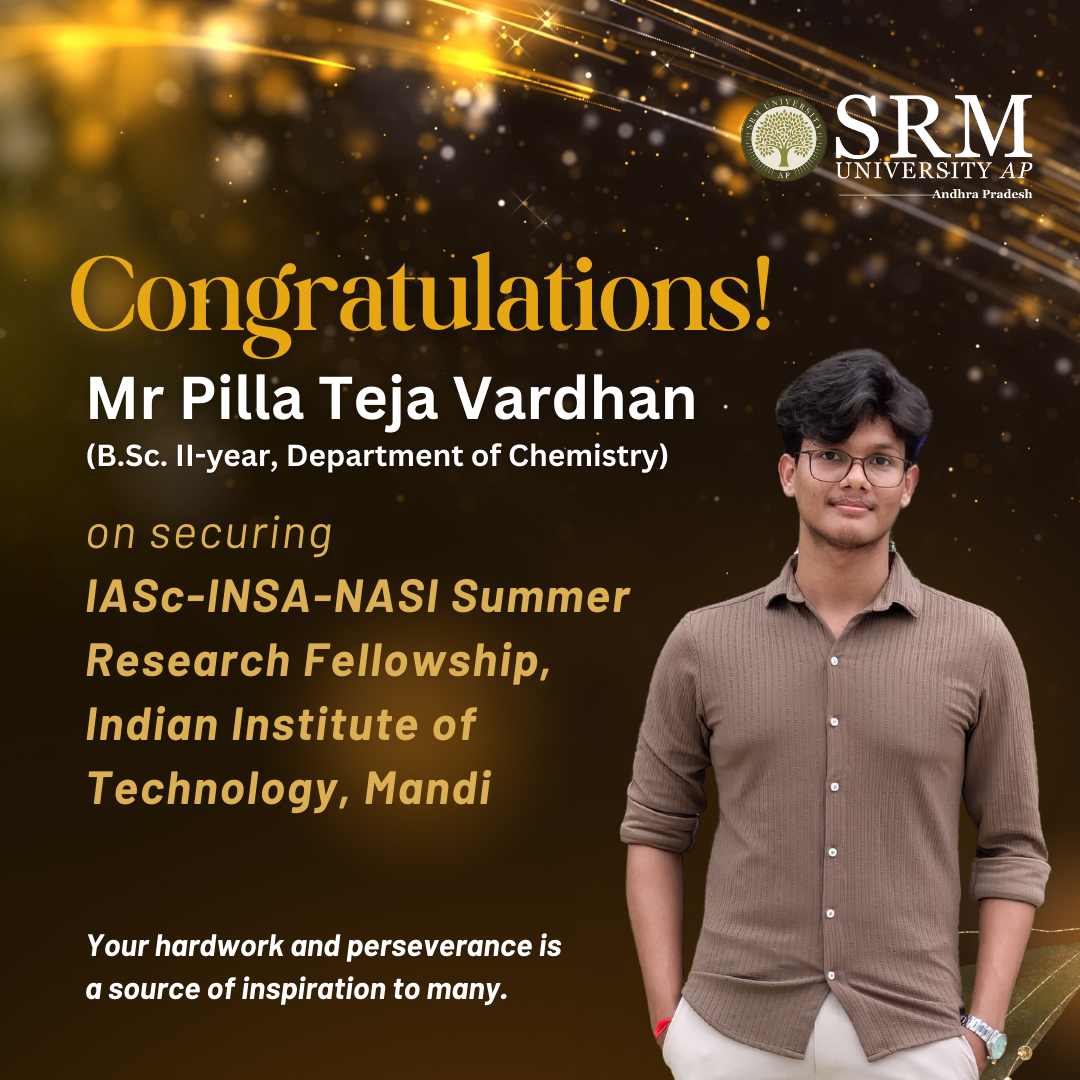 Mr Pilla Teja Vardhan, a second-year B.Sc. Chemistry student, has been selected for the highly prestigious IASc-INSA-NASI Summer Research Fellowship 2025. This esteemed fellowship is jointly offered by the Indian Academy of Sciences (IASc), Indian National Science Academy (INSA), and The National Academy of Sciences, India (NASI) India’s premier scientific institutions committed to nurturing research talent across the country.
Mr Pilla Teja Vardhan, a second-year B.Sc. Chemistry student, has been selected for the highly prestigious IASc-INSA-NASI Summer Research Fellowship 2025. This esteemed fellowship is jointly offered by the Indian Academy of Sciences (IASc), Indian National Science Academy (INSA), and The National Academy of Sciences, India (NASI) India’s premier scientific institutions committed to nurturing research talent across the country.
As part of this elite program, Teja Vardhan will spend eight weeks at the Indian Institute of Technology (IIT), Mandi, under the expert mentorship of Dr Amit Jaiswal, engaging in cutting-edge research in the field of Nanomatter and advanced material chemistry. This opportunity will enable him to gain valuable hands-on research experience, deepen his scientific insight, and contribute to ongoing investigations in frontier areas of science.
The IASc-INSA-NASI Summer Research Fellowship is known for its rigorous selection process and generous support. Selected students receive a monthly stipend of ₹12,500. The fellowship ensures a fully supported and immersive research experience at some of India’s leading scientific institutions.
About the Fellowship
The IASc-INSA-NASI Summer Research Fellowship Program is one of India’s most competitive undergraduate research initiatives, designed to provide meritorious students with exposure to advanced scientific research. Fellows work closely with leading researchers across academic and national laboratories, fostering a strong foundation for future scientific careers.
- Published in Chemistry-news, Departmental News, News, Research News, Students Achievements
Synthesising Copper-based Particles to Recycle Industrial Mineral Waste into Useful Products
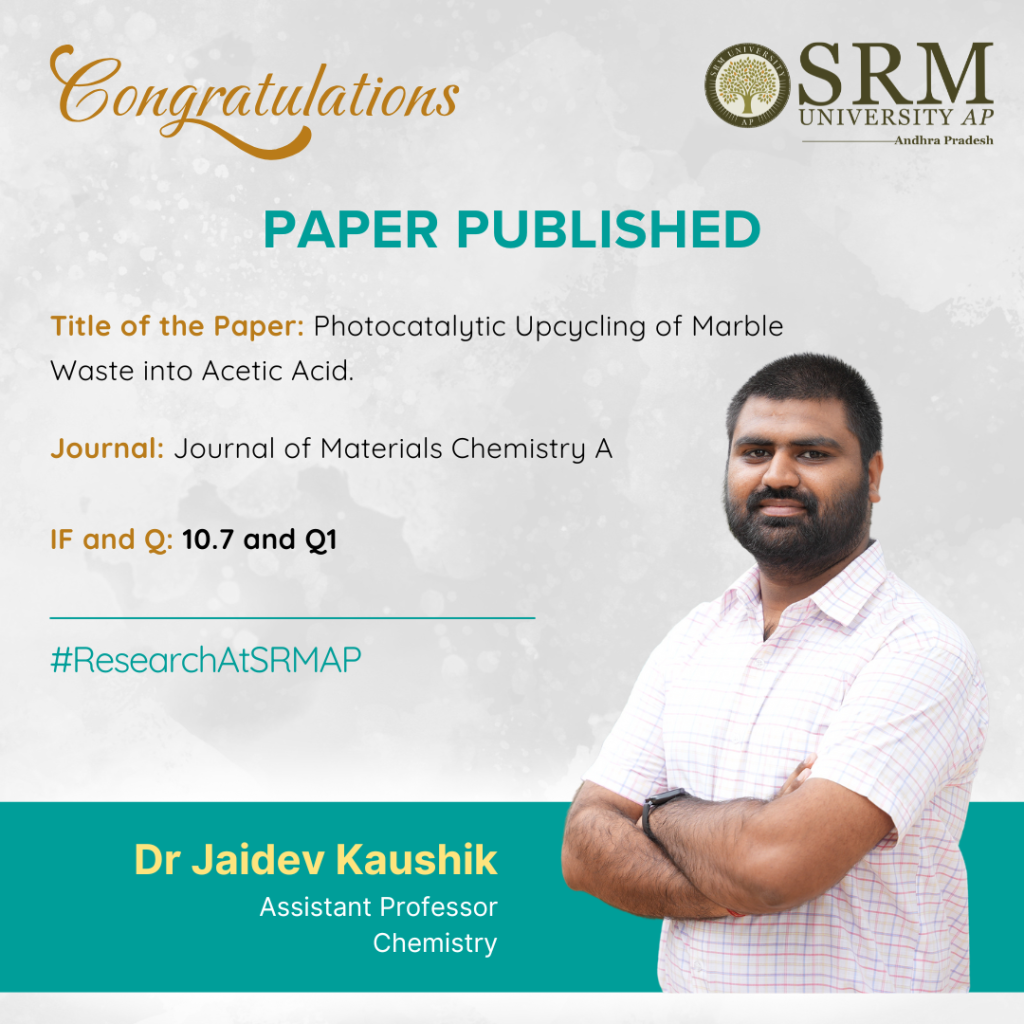
In an attempt to recycle industrial mineral waste into useful products, Dr Jaidev Kaushik from the Department of Chemistry has worked on synthesising copper-based particles that use light to convert carbonate-rich materials like marble dust into acetic acid, a valuable chemical used in industry and fuel production. He has published his research in a paper titled “Photocatalytic Upcycling of Marble Waste into Acetic Acid” in the prestigious Journal of Materials Chemistry A, having an impact factor of 10.7.
The particles drive the reaction efficiently by illuminating the green light on a mixture of the material and hydrogen peroxide solution. He has also tested the method on other carbonate wastes like chalk dust and scale, showing its potential for recycling industrial mineral waste into useful products.
Abstract
In this study, disk-shaped copper sulfide nanoparticles (CuS-NPs) were synthesised via a simple co-precipitation method and used as a photocatalyst for the reduction of carbonate species derived from marble dust into acetic acid (AcOH), an important industrial and biofuel precursor. The photocatalytic reaction was carried out under monochromatic light (525 nm) in a hydrogen peroxide–water mixture, which served as an electron and radical-rich medium. Key parameters such as solvent composition, light source, catalyst concentration and reaction time were optimised to get the maximum yield of AcOH. The reaction mechanism was investigated using radical scavenging experiments. The practical applicability of the approach was further tested on two additional real-life carbonate waste materials, i.e. chalk dust and scale.
Practical Implementation/ Social Implications of the Research
This research offers a sustainable method to convert carbonate-rich industrial wastes like marble dust, chalk dust, and scale into acetic acid, which is widely used in the chemical, pharmaceutical, and biofuel industries. By using light-driven reactions with safe, low-cost materials, the process reduces environmental pollution, supports waste valorisation, and contributes to a circular economy. It can be implemented in industries that generate carbonate waste, promoting green chemistry and lowering dependence on fossil-based raw materials.
Collaborations
Dr Sumit Kumar Sonkar (MNIT Jaipur, India)
Future Research Plans
- The adsorption/photodegradation-assisted quick and efficient removal of next-generation advanced pollutants such as microplastic, pesticides, pharmaceutical waste, etc., by hydrophobic carbon aerogel and their doped and functionalised versions.
- Utilising waste-derived heterogeneous catalysts in organic transformation reactions.
- Selective sensing of toxic metal ions/biomarkers/biomolecules using fluorescent nanomaterials.
- Upcycling of carbonates/CO2 via photo/thermal assisted catalysed reactions to get C1 and C2 hydrocarbons (green fuel).
- Reduction of nitrates/N2 via photo/thermal-assisted catalysed reactions to ammonia.
Link to the article
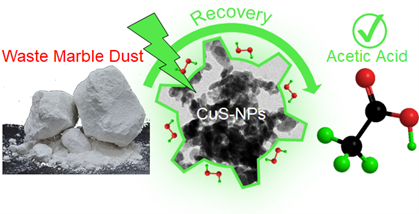
- Published in Chemistry-news, Departmental News, News, Research News
Folded Aromatic Polyamides Enabling Faster Charge Transport
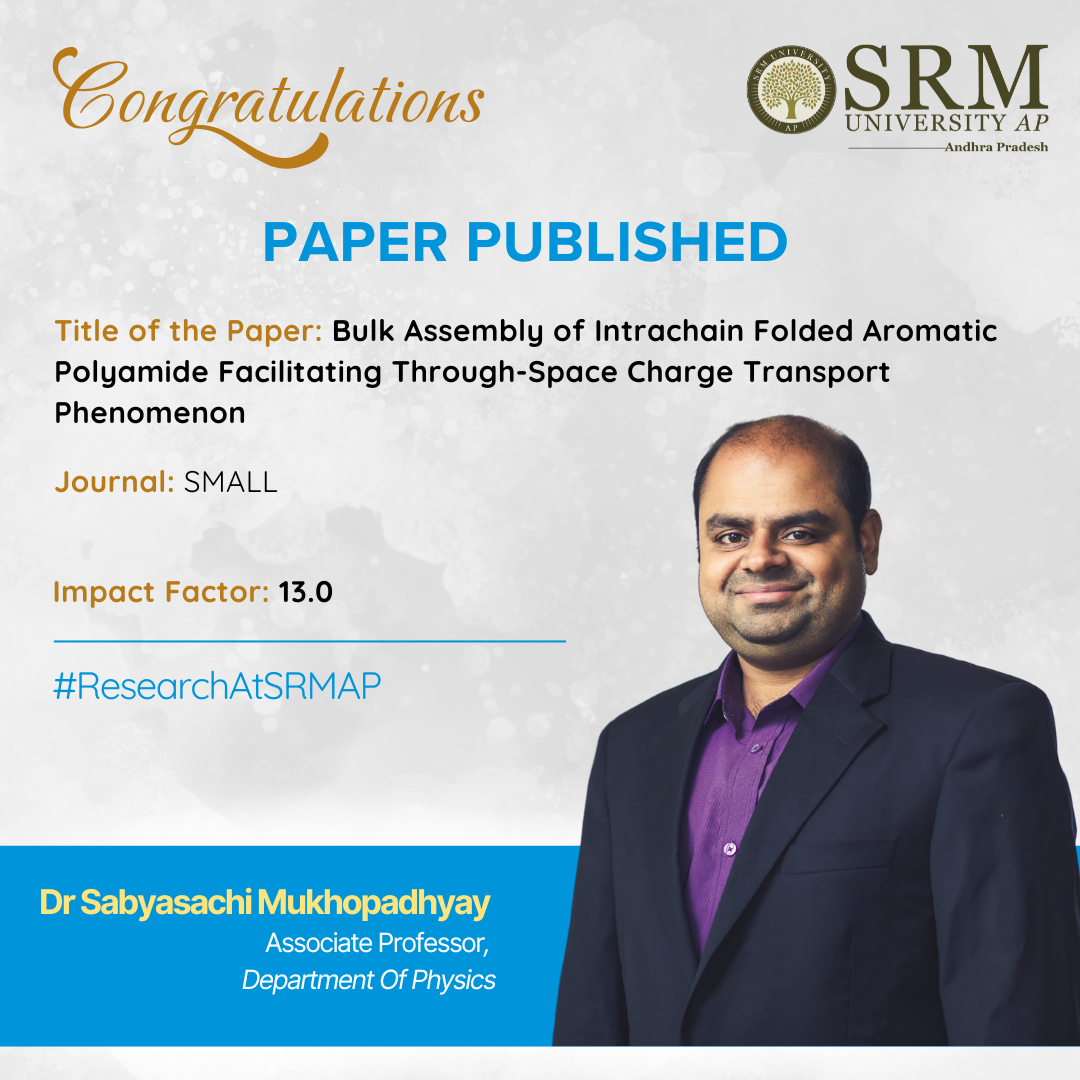 In the quest for next-generation organic electronic materials, researchers have drawn inspiration from nature’s intricate designs. A groundbreaking study titled “Bulk Assembly of Intrachain Folded Aromatic Polyamides Facilitating Through-Space Charge Transport Phenomenon” led by Dr Sabyasachi Mukhopadhyay, Associate Professor in the Department of Physics, introduces a novel class of polymers that mimic the secondary structures of biomolecules. Published in the high-impact Q1 journal SMALL with an Impact Factor of 13.0, this research unveils the potential of intrachain folded aromatic polyamides in facilitating efficient through-space charge transport.
In the quest for next-generation organic electronic materials, researchers have drawn inspiration from nature’s intricate designs. A groundbreaking study titled “Bulk Assembly of Intrachain Folded Aromatic Polyamides Facilitating Through-Space Charge Transport Phenomenon” led by Dr Sabyasachi Mukhopadhyay, Associate Professor in the Department of Physics, introduces a novel class of polymers that mimic the secondary structures of biomolecules. Published in the high-impact Q1 journal SMALL with an Impact Factor of 13.0, this research unveils the potential of intrachain folded aromatic polyamides in facilitating efficient through-space charge transport.
Abstract :
This study presents the design and synthesis of periodically grafted aromatic Polyamides capable of intrachain folding, mimicking secondary structures seen in biomolecules. Leveraging the immiscibility between aromatic backbones and Polyethylene glycol (PEG) side chains, the polymers self-assemble into lamellar, phase-separated domains with ordered π-stacking.
The structural order is further enhanced by incorporating aromatic guest molecules, enabling efficient through-space charge transport. Structural and morphological investigations via SAXS, WAXS, AFM, and TEM confirm the formation of highly ordered π-domains. Charge transport measurements reveal vertical current densities as high as 10⁻⁴ A/cm² in annealed host–guest complexes, comparable to conventional conjugated polymers, demonstrating the potential of these materials for stable, anisotropic organic electronics.
Practical implementation :
This research provides a new strategy for designing flexible, stable, and efficient organic electronic materials without the need for traditional conjugated polymers. The ability to precisely control the orientation and spacing of conductive regions at
The nanoscale opens doors for:
- Wearable and stretchable electronics
- Flexible sensors and low-power devices
- Organic transistors and memory devices with tunable directionality
- Environmentally stable devices, useful in humid or high-temperature conditions
- These innovations can lower manufacturing costs, enhance sustainability, and enable novel applications in healthcare, IoT, and smart textiles.
This research was a collaborative effort between multiple departments and institutions including Department of Chemical Sciences, IISER Mohali, Department of Physical Sciences, IISER Mohali and Department of Physics, SRM University – AP (Ramkumar K, Dr Sabyasachi Mukhopadhyay) and was supported by Department of Science and Technology – Science and Engineering Research Board (DST-SERB)
Future research plans:
Dr Sabyasachi Mukhopadhyay is working towards “Integrated Center for Organic Electronics” – a multidisciplinary innovation hub focused on designing the next generation of flexible, sustainable, and high-performance electronic materials and devices.
- Published in Departmental News, News, Physics News, Research News
The ‘Unholy’ Trinity: Repression of the Working- Class in Late-Colonial Bengal
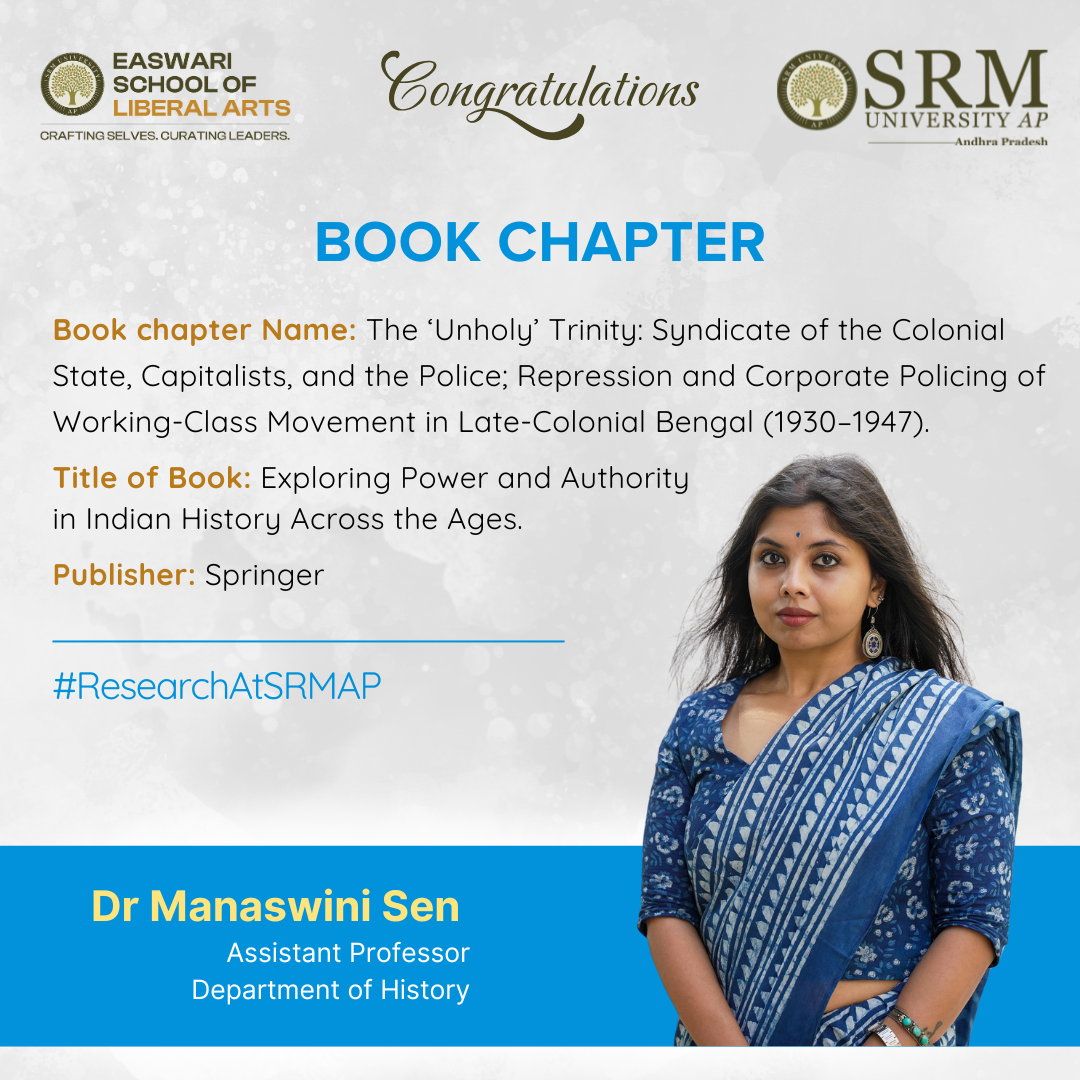 Dr Manaswini Sen, Assistant Professor in the Department of History at SRM University – AP, Amaravati in her chapter titled “The ‘Unholy’ Trinity: Syndicate of the Colonial State, Capitalists, and the Police; Repression and Corporate Policing of Working-Class Movement in Late-Colonial Bengal (1930–1947)”, published in Exploring Power and Authority in Indian History Across the Ages (Springer), investigates how the colonial state, capitalist interests, and the police referred to as the “unholy trinity”collaborated to repress working-class movements in late-colonial Calcutta between 1930 and 1947.
Dr Manaswini Sen, Assistant Professor in the Department of History at SRM University – AP, Amaravati in her chapter titled “The ‘Unholy’ Trinity: Syndicate of the Colonial State, Capitalists, and the Police; Repression and Corporate Policing of Working-Class Movement in Late-Colonial Bengal (1930–1947)”, published in Exploring Power and Authority in Indian History Across the Ages (Springer), investigates how the colonial state, capitalist interests, and the police referred to as the “unholy trinity”collaborated to repress working-class movements in late-colonial Calcutta between 1930 and 1947.
The study examines the complex interests of the capitalist class and the British imperial state in late colonial India, focusing on their collective oppression towards labor radicalisation. It examines the legal measures taken by the British imperial state to monitor working-class militarisation and the strategies employed by capitalists to disrupt strikes and deny workers’ claims.
The chapter also discusses the establishment of white or pro-state unions that used communalism to disrupt strikes and hinder revolutionary union movements in late colonial Calcutta. The chapter provides new perspectives on competition-collaboration theories, discusses the role of Indian capitalists, and explores the question of communalism in trade union politics in late colonial Bengal. It is relevant for those working in labour history, mass movement history, late colonial Calcutta, and urban history.
About the book :
Exploring Power and Authority in Indian History Across the Ages offers a nuanced exploration of power and authority in Indian history through a series of case studies spanning different regions and time periods. It examines the sociological, cultural, economic, and historical dimensions of power, critiques dominant ideologies, and highlights responses from marginalised groups. Providing insights into diverse political structures from ancient to modern times, this volume is a valuable resource for historians, scholars, and researchers of Indian and South Asian history.
- Published in Departmental News, History Current Happenings, History News, News, Research News
Analysing Thermo-mechanical Bending Behaviour of Sigmoid FGM Sandwich Plate
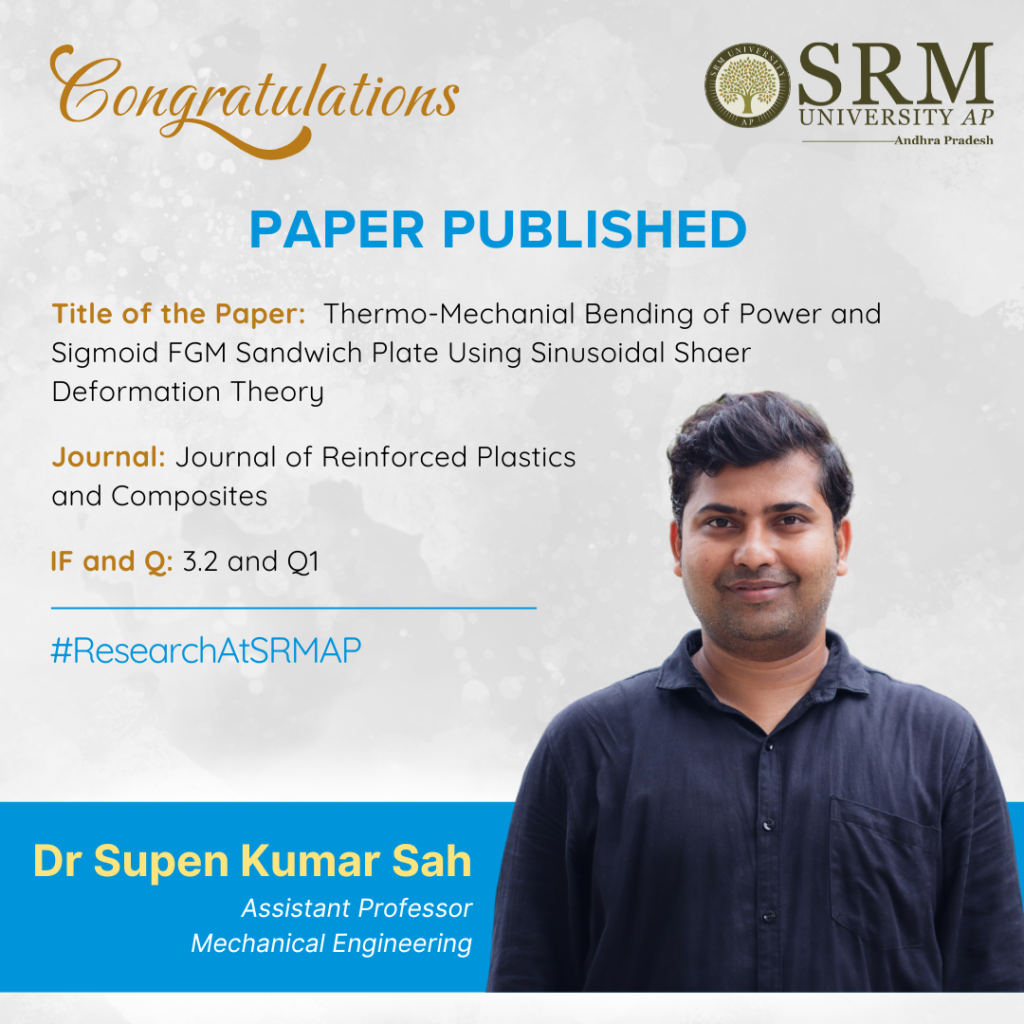
Dr Supen Kumar Sah, Assistant Professor at the Department of Mechanical Engineering presents his exclusive study on the thermo-mechanical bending behaviour of functionally graded material (FGM) sandwich plates using the Sinusoidal Shear Deformation Theory (SSDT) in his recent paper titled “Thermo-mechanical bending of power and sigmoid FGM sandwich plate using sinusoidal shear deformation theory”. The paper has been published in the Journal of Reinforced Plastics and Composites, having an impact factor of 3.2.
Abstract
This study examines the thermo-mechanical bending behaviour of functionally graded material (FGM) sandwich plates with temperature-dependent properties. FGMs, typically made from metal and ceramic, combine rigidity and high thermal resistance, and their properties are assumed to vary continuously in thickness. Using sigmoid and power law distributions, we analyse the smooth variation of properties and apply a one-dimensional heat conduction equation to determine temperature changes. The Sinusoidal Shear Deformation Theory (SSDT) is utilised to account for the sinusoidal distribution of shear stress while meeting traction-free boundary conditions. We derive the governing equations through Hamilton’s variational principle and Navier’s solution, resulting in closed-form solutions for center deflection, and normal and shear stresses of the plates. The analysis reveals that temperature-dependent properties and gradation indices significantly affect central deflection, normal stress, and shear stress. The SSDT results align well with existing shear deformation theory, confirming its accuracy.
Dr Sah collaborated with Dr Anup Ghosh from IIT Kharagpur on the research study. He aims to continue his research on FGMA and focus on the structural analysis of multidirectional Functionally Graded Material sandwich plates in the future.
- Published in Departmental News, Mechanical Engineering NEWS, News, Research News
Advancing Next-Gen PEM Fuel Cells: Role of Nanostructured Catalysts
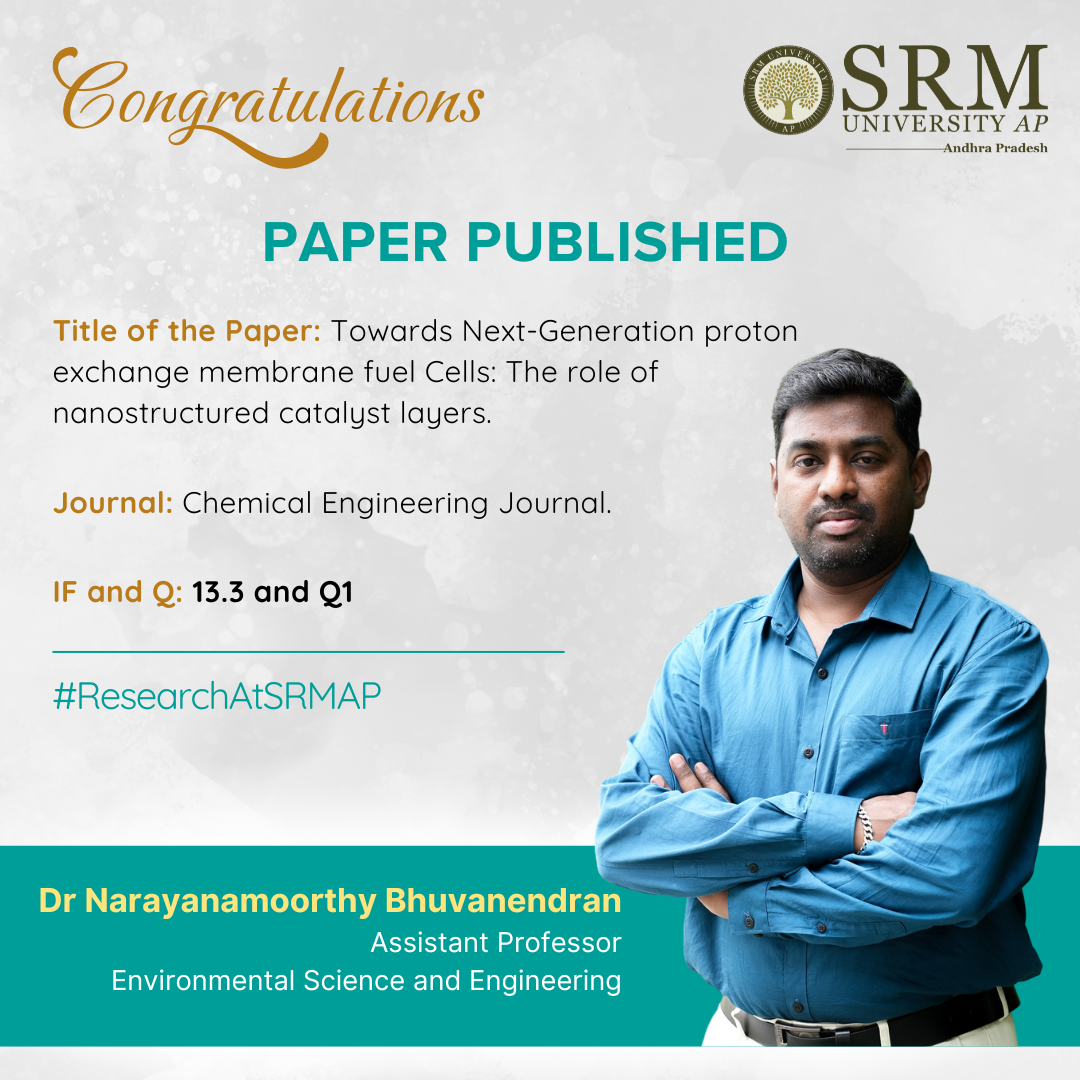 The transition to sustainable energy sources has become imperative due to the exhaustion of conventional resources caused by excessive use and their detrimental impact on the environment. Currently, alternative energy sources, such as solar, wind, nuclear, tidal, and geothermal energy, hydro have been introduced. Over the last few decades, focus has shifted to the use of hydrogen energy as a promising alternative to traditional power sources in almost all sectors requiring energy applications.
The transition to sustainable energy sources has become imperative due to the exhaustion of conventional resources caused by excessive use and their detrimental impact on the environment. Currently, alternative energy sources, such as solar, wind, nuclear, tidal, and geothermal energy, hydro have been introduced. Over the last few decades, focus has shifted to the use of hydrogen energy as a promising alternative to traditional power sources in almost all sectors requiring energy applications.
However, a major challenge holding back their widespread use is the high cost and limited performance of a key component called the catalyst layer (CL). This layer is responsible for speeding up the chemical reaction that generates electricity, but it typically requires a large amount of platinum, a rare and expensive metal and often has a thick, disordered structure that reduces efficiency.
This research, titled “Towards Next-Generation proton exchange membrane fuel Cells: The role of nanostructured catalyst layers” led by Dr. Narayanamoorthy Bhuvanendran, Assistant Professor, Department of Environmental Science and Engineering, was published in the Q1 Journal, Chemical Engineering Journal, with an Impact Factor of 13.4. The paper focuses on designing advanced nanostructured catalyst layers that are thinner, more organised, and use much less platinum. These next-generation CLs can help fuel cells perform better, last longer, and become more affordable.
The study reviews recent progress in this field, highlights innovative methods for creating these new structures, and outlines future directions to improve their practicality and environmental impact. Ultimately, this work aims to bring us closer to clean, efficient, and widely accessible fuel cell technology.
Fuel cells offer clean energy with zero emissions when using hydrogen, and higher energy efficiency than diesel or gas engines. Among them, Proton Exchange Membrane Fuel Cells (PEMFCs) are one of the most promising technologies. PEMFCs produce only water as a byproduct, making them a clean energy alternative to fossil fuels.
Abstract:
Catalyst layer (CL) is the major component of proton exchange membrane fuel cells (PEMFCs) and routinely fabricated by a catalyst ink-based processing method. Such conventional CLs typically confront low activity, unaffordable Pt loading, and severe mass transport issues due to the thick and disordered structure, hampering the widespread commercial application of PEMFCs.
Engineering of nanostructured CLs with low/ultralow Pt loading, ordered and/or ultrathin CLs, provides a highly promising pathway for overcoming these limitations. For the practical application of the nanostructured CLs in PEMFCs, this review comprehensively summarises and comments on the important research and development of nanostructured CLs over recent years, involving ordered electronic conductor-based CLs, ordered ionomer-based CLs, and ultrathin CLs.
The reviewed processes include
(i) analysing the motivation and necessity to design and fabricate nanostructured CLs based on the structure and mass transport process of conventional CLs,
(ii) scrutinising structure and composition, preparation methods, advantages, as well as
some feasible strategies for the remaining challenges of various nanostructured CLs in
detail,
(iii) the progress of single cell activity and durability of the nanostructured CLs. Finally, some perspectives on remaining challenges and future development of the nanostructured CLs are presented to guide the exploitation for the next-generation of advanced CLs of PEMFCs.
Practical implementations:
The practical objective of this study is to facilitate the development of more efficient, cost-effective, and durable proton exchange membrane fuel cells (PEMFCs) through the redesign of the catalyst layer utilising advanced nanostructures. This enhancement has the potential to substantially decrease dependence on costly platinum, reduce production expenses, and enhance the overall performance of fuel cells.
In terms of societal impact, this research contributes to the transition towards clean and sustainable energy systems, thereby reducing greenhouse gas emissions and air pollution associated with conventional fossil fuels. By making fuel cell technology more accessible and scalable, particularly for transportation and portable power applications, it supports global initiatives to combat climate change and improve energy security for future generations.
Collaborations:
Prof. Huaneng Su, Institute for Energy Research, Jiangsu University, Zhenjiang, China.
- Published in Departmental News, ENVS News, News, Research News
Critical agendas for the areal linguistics: locating Sindhi within South Asia
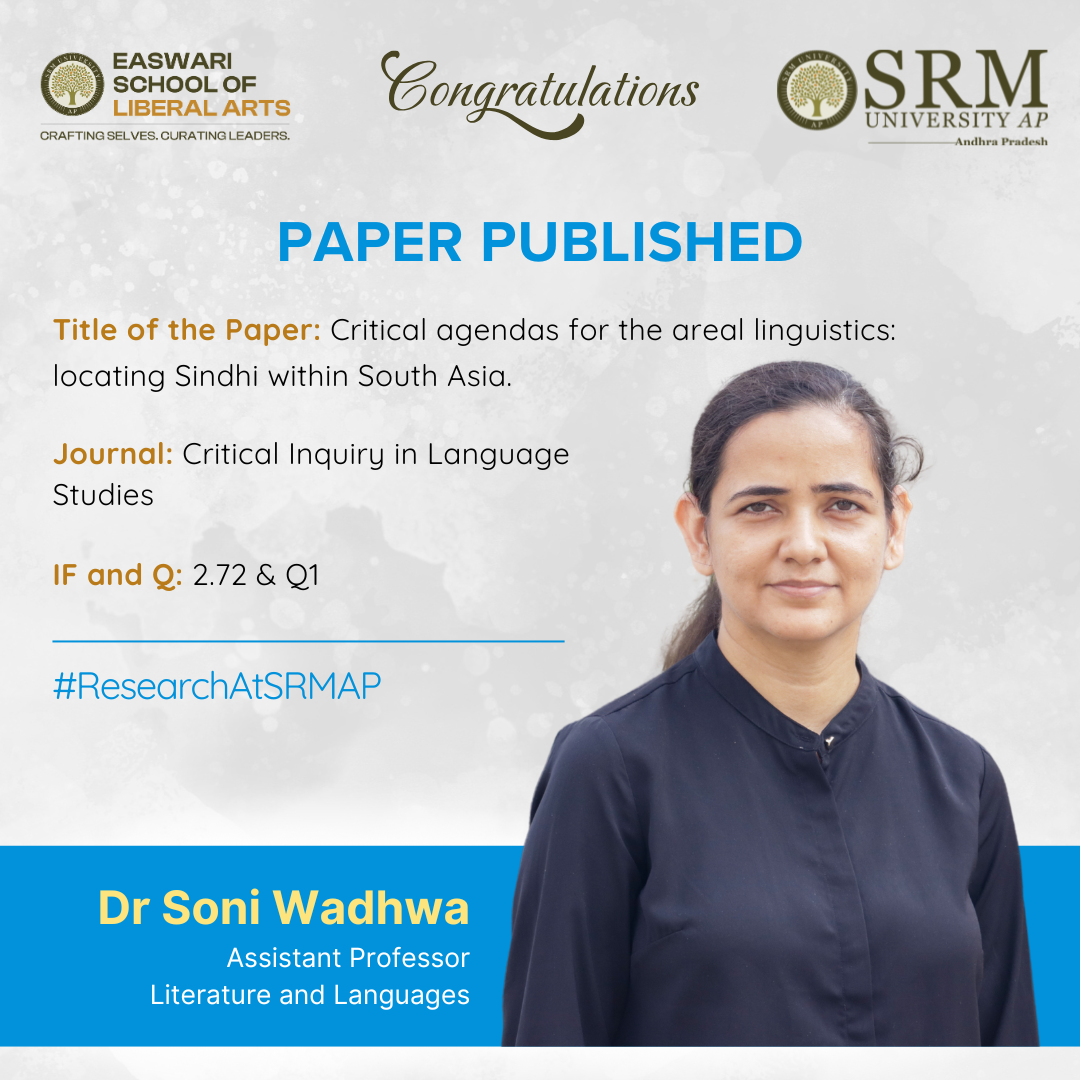 The Sindhi language presents a compelling case for examining the intersections of language, territory, and identity in the post-Partition context. In India, Sindhi often survives as a spoken language, primarily confined to the domestic sphere. This restricted use raises important questions about the conditions necessary for linguistic vitality.
The Sindhi language presents a compelling case for examining the intersections of language, territory, and identity in the post-Partition context. In India, Sindhi often survives as a spoken language, primarily confined to the domestic sphere. This restricted use raises important questions about the conditions necessary for linguistic vitality.
Exploring the complexities surrounding Sindhi Dr Soni Wadhwa, Assistant Professor in the Department of Literature and Languages, has published a research article titled “Critical agendas for the areal linguistics: locating Sindhi within South Asia” in the Q1 journal Journal of Critical Inquiry in Language Studies. This publication contributes significantly to scholarly discussions on areal linguistics, offering critical insights into the precarious position of Sindhi and the broader implications for language studies in postcolonial South Asia.
This article explores these dynamics to foreground the often-overlooked role of technological, epistemological, and aesthetic resources in sustaining minority languages. In doing so, it positions Sindhi as a critical lens through which to understand the challenges faced by minoritised languages in the Global South, particularly those without a clear territorial anchoring.
Abstract
As a concept within applied linguistics, areal linguistics concerns itself with investigating the nature of structural similarities among languages produced by contact rather than by history or by genetic similarities. A critical look at its descriptive linguistic agendas reveals that the domain needs to be revisited in terms of questions of power relations and linguistic inequalities within specific linguistic
areas. Such investigations reconfigure the dynamics of geography and regionality within language as a site of power.
This study seeks to make an intervention into India as a linguistic area with a focus on Sindhi, a non-regional language in India. Given that the language and the community do not have a state or a linguistic territory within India, the condition of Sindhi is characterised by a sense of precarity. Seen through the prism of India as a linguistic area, this precarity is not quite visible. In revisiting the celebrated concept of India as a linguistic area, this study suggests ways of asking contemporary questions about areal linguistics that go beyond describing the nature of contact among languages, and instead ask how this contact impacts the markers of hegemony over minor languages in terms of technological,epistemological, and aesthetic leverage.
Social Implications of the Research
This research might help in building further study around minority languages in India as well as elsewhere in the Global South, we empower more languages. This will help people who know regional languages access the Internet and other aspects that Digital India aspires to address.
Sindhis in India are scattered in different cities and speak the regional or state languages or English at home. This work helps in pushing more research on the language and the community which can further inform policies for linguistic empowerment.
- Published in Departmental News, English Current Happenings, News, Research News
A Full-bridge Multiple-load LED Driver Offering Clean Energy
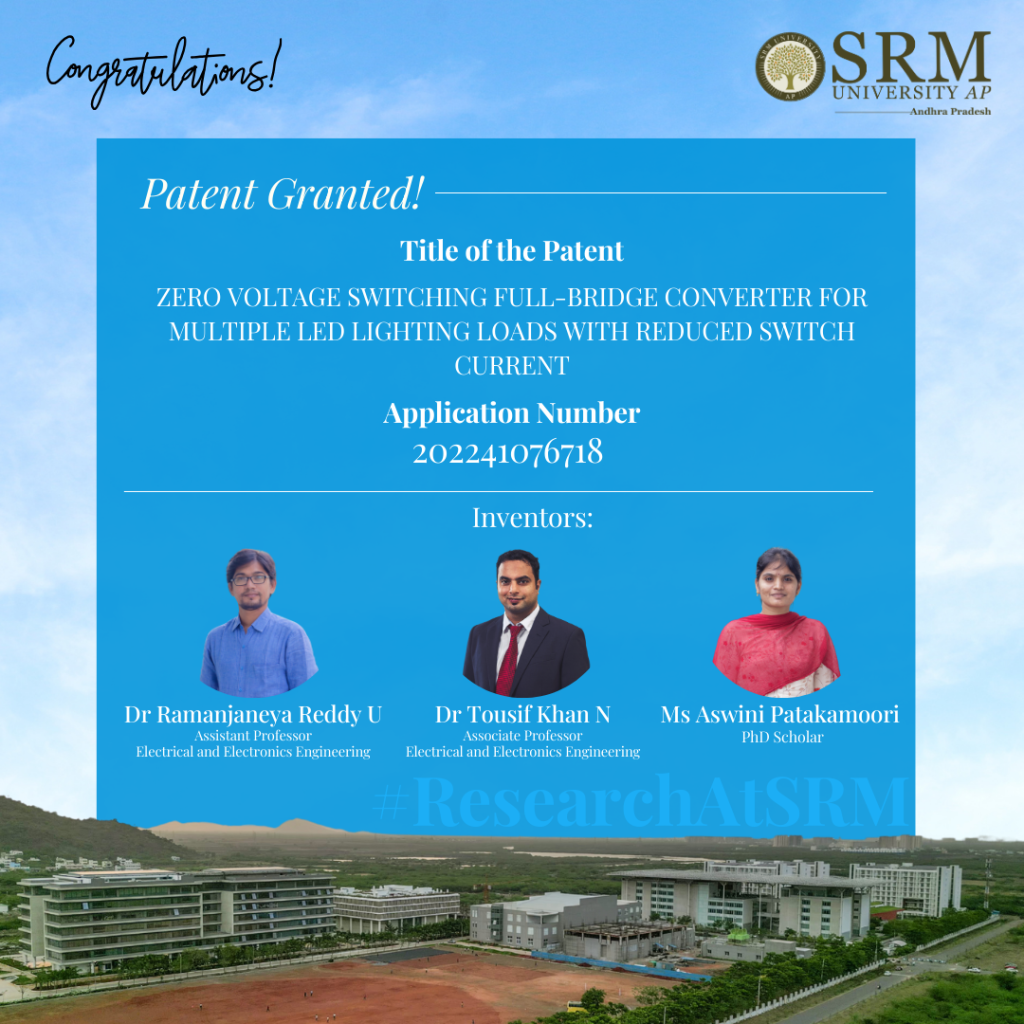
The Department of Electrical and Electronics Engineering proudly announces that the invention “Zero Voltage Switching Full-bridge Converter for Multiple LED Lighting Loads with Reduced Switch Current” with Application number: 202241076718 has been granted to Dr Ramanjaneya Reddy, Assistant Professor, Dr Tousif Khan Nizami, Associate Professor, and Ms Aswini Patakamoori, PhD Scholar in the Indian Patent Office Journal.
The research focuses on creating an energy-efficient power supply for LED lights, especially in areas that use a DC electricity system. The team has designed a system that can power multiple LED lights from a single unit, saving energy and cost. This system works at a very high efficiency of about 97.5%, which means very little energy is wasted as heat.
The special design uses a method called “soft switching,” which helps the internal parts of the system turn on and off with less stress, reducing heat and improving lifespan. It also needs fewer parts for each light, making it simpler, more reliable, and cheaper to produce. Additionally, the system allows the lights to be dimmed easily using a basic on-off control method, giving flexibility in brightness as needed.
Abstract
A 110 W soft-switched full-bridge multiple load LED driver is designed for DC-grid applications, achieving a high efficiency of 97.52%. The full-bridge configuration ensures that the switches carry minimal current, reducing conduction losses, and offers zero-voltage switching, significantly lowering switching losses. The reduced component count per lamp simplifies the design, enhances reliability, and reduces overall system costs. Additionally, the driver supports PWM-based dimming through simple on-off control, offering flexibility in illumination levels.
Practical Implementation/ Social Implications of the Research
The developed 110 W soft-switched full-bridge multiple-load LED driver is a highly efficient and scalable solution tailored for DC-grid applications, particularly those integrated with solar and battery-based energy systems. Operating at an impressive efficiency of 97.52% ensures minimal energy loss. This technology promotes sustainable development by enabling cleaner energy usage and reducing carbon emissions. Its simple, cost-effective design makes advanced lighting more accessible, especially in low-income or remote communities. Additionally, the ability to dim lights easily helps conserve energy further and allows users to adapt lighting to different needs, enhancing comfort and minimising waste.
Future Research Plans
To design more efficient, adaptable, and sustainable LED driver circuits,
- Extending soft-switching techniques to automotive, industrial, and smart lighting systems for broader applications.
- Incorporating digital control strategies for intelligent dimming, adaptive power regulation, and real-time performance monitoring.
- Exploring advanced semiconductor materials, such as Gallium Nitride (GaN) and Silicon Carbide (SiC), to enhance switching performance and thermal stability. Integration of energy harvesting techniques to create self-sustaining LED driver systems powered by renewable sources such as solar energy.
- Published in Departmental News, EEE NEWS, News, Research News


